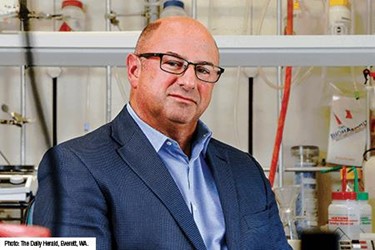How Seattle Genetics Got Bill Gates And Paul Allen As Investors
By Rob Wright, Chief Editor, Life Science Leader
Follow Me On Twitter @RfwrightLSL

When I sat down to interview Clay Siegall, founder, president, CEO, and chairman of Seattle Genetics for the 2018 March issue of Life Science Leader, it was while we were both in San Francisco this past January for the 36th Annual J.P. Morgan Healthcare Conference (JPM). Our conversation actually began with him asking me a question. On the table between us was the 2018 January issue featuring Joseph Papa. Siegall pointed to the cover and asked, “So do you think he’ll be able to turn Valeant around?” Oh, the value of still having a print publication! We discussed the challenges faced by Papa, and both agreed we think he is on the right path.
Interviewing an executive in person often provides for such interesting and unplanned exchanges. During our conversation in San Francisco, we discussed things like how Seattle Genetics became somewhat of an accidental startup incubator, which you can read more about here. In this latest installment of Life Science Leader’s exclusive online section of Beyond The Printed Page, we delve into another interesting story — how he was able to get two of the wealthiest people in the world (Microsoft cofounders Bill Gates and Paul Allen) to invest in Seattle Genetics. We hope you enjoy this latest Beyond The Printed Page installment, and will consider becoming a subscriber — today.
Whatever Happened To The Other Cofounder Of Seattle Genetics?
H. Perry Fell, Ph.D., and Clay Siegall, Ph.D., not only worked together at Bristol-Myers Squibb, together they conceived the idea of Seattle Genetics. “Perry and I started Seattle Genetics, and he worked here for a number of years, serving as the CEO until November 2002,” Siegall shares. But in 2003, it was announced that Fell was stepping down from his role, though he’d remain chairman of the board. Today, however, Fell has no affiliation with the company, making you wonder if there was a bit of a Fell-ing out (pun intended). “Not at all,” Siegall assures. “He’s a very ambitious guy and simply decided to move on to his next endeavor.” According to Siegall, Fell enjoys the process of building companies, but when it comes to developing drugs, not so much. “He’d say to me, you’re a drug developer, but developing drugs is a lot of Gantt charts, and that’s just not me.” After leaving Seattle Genetics, Fell went on to help found several other companies, such as NanoString Technologies, where he served as the president and CEO from 2004 – 2009, and Impel Neuropharma. “I think that is what he really likes doing,” Siegall states. “But, as for me, I am not looking to found company after company. I’m a cancer drug developer. That’s what I do.”
How Did Bill Gates And Paul Allen Become Investors In Seattle Genetics?
Founding a startup biopharmaceutical company is not for the faint of heart. There are significant challenges associated with bringing a new therapeutic to market. And while roughly 8 out of 10 entrepreneurs who start businesses fail within the first 18 months, considering that it takes an average of 14 years and about a billion dollars to get a new therapeutic approved, you’d have to imagine the odds of failure are probably even higher for biopharmaceutical startups. But what if two of your investors happen to be Bill Gates and Paul Allen? Might you have a little more confidence in the likelihood of success? This is what happened to Siegall.
“After Fell and I cofounded the company, I was the main presenter of our data and information to potential investors,” Siegall shares. “We talked to VCs in Seattle, the bay area, and New York.” In addition, the entrepreneurs had the gumption to contact the investment firms of Gates (i.e., Cascade Investment), and Allen (i.e., Vulcan Ventures). “We didn’t speak with Gates and Allen directly; we interacted with their staff when we were seeking series A funding,” he says. “We were unsuccessful.”
Siegall proceeds to explain how some VCs like to specialize in series As, while others have a preference for later types of deals, such as mezzanine (i.e., bridge) financing. “The folks at Cascade and Vulcan said they liked what we were doing, but suggested we seek VCs specializing in series A, but to please keep them updated,” he states. Siegall says he continued to make appointments to speak to their staff, even when they didn’t invest. “Every couple of months I would call and tell them what we were up to and provide a progress report,” he affirms. “Then when we were ready for series B financing, they were already very familiar with what we were doing, and that’s when they decided to invest.”
Siegall says this is an important lesson he tries to impart to prospective entrepreneurs. “When starting a company, assuming you have properly targeted your various investor groups, you never hear no,” he asserts. “What you hear is ‘not now.’” His advice when someone says they aren’t willing to invest in you is to find out what the VC is thinking. “Why aren’t they interested in investing?” he probes. “Is it a timing thing? Do they not like what you’re working on?” And even if they said no, he advises to keep them updated. “People invest in new companies for two reasons, the technology or the management team,” he states. For when it comes to securing financing, it is important to not only be persistent, but consistent with your message and your progress. “This is how we were able to get Gates and Allen as relatively early-stage investors, which is something we are quite proud of,” he concludes.
